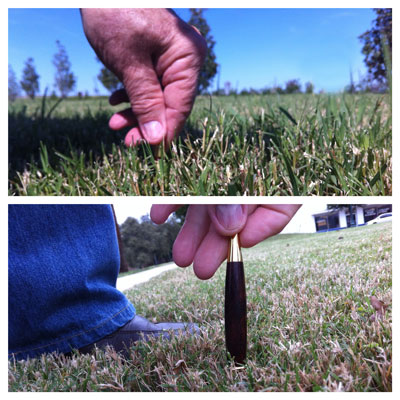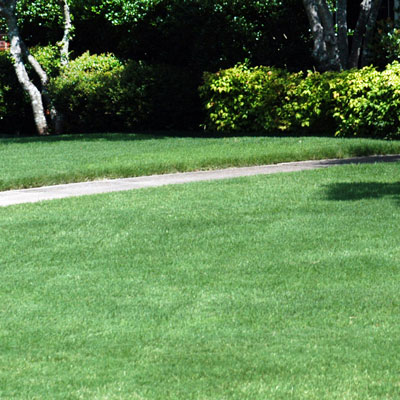Question of the Week: July 14, 2016
“Neil. Should I mow my lawn higher to help it survive the summer heat better?”
No! Almost never. My old statement has always been that “Tall grass becomes weak grass.”

I used the same pen to illustrate two different mowing heights. Grass in top photo had been maintained too high. Weeds had invaded.
When you mow a lawn taller than the recommended mowing height for whatever type of grass you have, you’re going to be inviting weeds to move in. As the grass grows taller, its blades start to grow upward, as some would say, “looking for light.” It ends up resembling some kind of sparse wire brush.
Compare that with grass that’s kept short. It’s dense and spreading. Runners grow far and wide. Weeds have a hard time getting started. The best comparison I can give you would be a fine golf course, where the greens are maintained at 1/4-inch or less. 30 yards away is that waist-high rough of tall grass and weeds. If they’d keep that area mowed short, the tall grass and weeds would disappear, but of course, they want that look to keep us all humble.
I have a second example for the non-golfers among us. You probably have seen bermuda that has gotten started in the cracks of a street or alleyway. Cars run over it every day. They keep it beaten down, yet grows into a solid tuft like a green and weed-free natural pincushion.

This turf is being maintained at the proper height. Note the varying of mowing patterns to keep the grass from developing a “grain.”
Best Mowing Heights
Common bermudagrass: 1-1/4 to 1-1/2 in.*
Hybrid bermudagrasses: (there are dozens): Best height will depend on variety. Athletic turf types should be 1/4- to 3/4-in., and they must be maintained with a reel mower, not rotary.
Seeded types of hybrid bermuda at 1-1/4 to 1-1/2 in. Rotary blades are good there.
St. Augustine: 2 to 3 inches. There is no reason ever to vary it.
Zoysias (there are many): 2 to 3 inches, depending on type and texture (turf’s blade width).
Buffalograss: 3 to 4 inches.
Fescue: 3 to 4 inches.
Winter rye: same height as the permanent turf
* When maintaining bermudagrass turf, a case can be made for raising the mower blade one notch in early summer. By mid- or late June you may be noticing browned spots in your lawn for a few days after you mow. About the time the grass greens up, it’s time to mow it again, and the cycle starts over.
You’re mowing into stem stubble, thereby removing all the green blades. By raising the blade one (only one!) notch, you’ll bypass that problem. But remember to drop the blade down that one notch come February, before new growth begins. And keep in mind that commercial maintenance companies find a compromise intermediate height where they won’t have make all those adjustments. You can probably do so as well.
